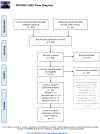A systematic review of scabies transmission models and data to evaluate the cost-effectiveness of scabies interventions
- PMID: 30849124
- PMCID: PMC6426261
- DOI: 10.1371/journal.pntd.0007182
A systematic review of scabies transmission models and data to evaluate the cost-effectiveness of scabies interventions
Abstract
Background: Scabies is a common dermatological condition, affecting more than 130 million people at any time. To evaluate and/or predict the effectiveness and cost-effectiveness of scabies interventions, disease transmission modelling can be used.
Objective: To review published scabies models and data to inform the design of a comprehensive scabies transmission modelling framework to evaluate the cost-effectiveness of scabies interventions.
Methods: Systematic literature search in PubMed, Medline, Embase, CINAHL, and the Cochrane Library identified scabies studies published since the year 2000. Selected papers included modelling studies and studies on the life cycle of scabies mites, patient quality of life and resource use. Reference lists of reviews were used to identify any papers missed through the search strategy. Strengths and limitations of identified scabies models were evaluated and used to design a modelling framework. Potential model inputs were identified and discussed.
Findings: Four scabies models were published: a Markov decision tree, two compartmental models, and an agent-based, network-dependent Monte Carlo model. None of the models specifically addressed crusted scabies, which is associated with high morbidity, mortality, and increased transmission. There is a lack of reliable, comprehensive information about scabies biology and the impact this disease has on patients and society.
Discussion: Clinicians and health economists working in the field of scabies are encouraged to use the current review to inform disease transmission modelling and economic evaluations on interventions against scabies.
Conflict of interest statement
I have read the journal's policy and the authors of this manuscript have the following competing interests: - Michelle Dowden is program director at One Disease. - David Regan was involved in developing one of the four described scabies transmission models (Lydeamore et al.). - Naomi van der Linden, Kees van Gool, Karen Gardner, Helen Dickinson, Jason Agostino and Rosalie Viney work on the evaluation of One Disease program interventions. - Naomi van der Linden was employed at the Centre for Health Economics Research and Evaluation while the work was performed. She currently works at AstraZeneca Netherlands.
Figures


References
-
- Swe PM, Christian LD, Lu HC, Sriprakash KS, Fischer K. Complement inhibition by Sarcoptes scabiei protects Streptococcus pyogenes—An in vitro study to unravel the molecular mechanisms behind the poorly understood predilection of S. pyogenes to infect mite-induced skin lesions. PLoS neglected tropical diseases. 2017;11(3):e0005437 Epub 2017/03/10. 10.1371/journal.pntd.0005437 - DOI - PMC - PubMed
-
- WHO. Scabies 2017 [Accesed 29/08/2017]. Available from: http://www.who.int/lymphatic_filariasis/epidemiology/scabies/en/.
-
- Goldstein BGG, A.O. Scabies 2017 [Accessed 16/08/2017]. Available from: https://www-uptodate-com.ezproxy.lib.uts.edu.au/index.html#!/contents/sc....
Publication types
MeSH terms
Substances
LinkOut - more resources
Full Text Sources
Medical

